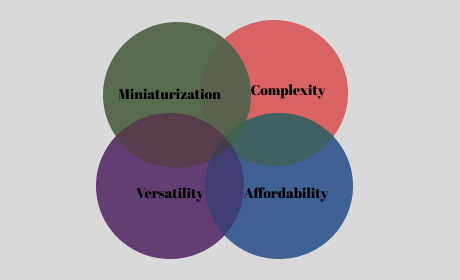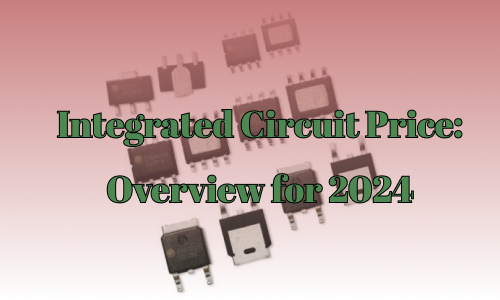Integrated circuits (ICs) – the tiny brains behind our gadgets, gizmos, and everything in between. But have you ever wondered: how much do these microscopic marvels actually cost?
Prepare to dive into the price labyrinth of Integrated Circuit Price! This blog will dissect the functions, explore their ranges, and equip you with the knowledge to navigate the electronics marketplace like a pro.

What is an Integrated Circuit
An Integrated Circuit (IC), also known as a microchip or chip, is a small semiconductor wafer on which thousands to millions of tiny electronic components such as transistors, diodes, and resistors are fabricated. These components are interconnected to perform a specific function or a series of functions within an electronic circuit. Integrated circuits revolutionized the field of electronics by enabling the miniaturization of complex electronic systems, leading to the development of powerful and compact electronic devices.
Integrated circuits can be classified into different categories based on their complexity and functionality:
-
Analog Integrated Circuits: Analog ICs are designed to manipulate continuous signals such as audio, radio frequencies, or temperature. Examples include amplifiers, voltage regulators, and voltage comparators.
-
Digital Integrated Circuits: Digital ICs operate with discrete values (bits) and are used for tasks such as arithmetic operations, logic functions, and data storage. Examples include microprocessors, memory chips, and logic gates.
-
Mixed-Signal Integrated Circuits: Mixed-signal ICs combine both analog and digital circuitry on the same chip. These are commonly used in applications that require processing both analog and digital signals, such as in data converters and communication systems.
Integrated circuits offer several advantages, including:
-
Miniaturization: ICs allow for the integration of numerous components on a tiny chip, reducing the size of electronic devices while increasing functionality.
-
Improved Reliability: Compact design reduces the number of interconnections and solder points, leading to improved reliability and reduced susceptibility to external factors.
-
Higher Performance: Integrated circuits enable faster processing speeds, lower power consumption, and increased computational power compared to discrete electronic components.
-
Cost Efficiency: Mass production of ICs lowers manufacturing costs, making electronic devices more affordable for consumers.
-
Ease of Design: Using pre-designed ICs simplifies the design process and reduces the time required to develop complex electronic systems.
Integrated circuits are essential components in various electronic devices, including smartphones, computers, medical devices, automotive systems, and industrial equipment. They are the building blocks of modern electronics and have significantly contributed to advancements in technology and innovation.

The Characters of Integrated Circuits
When discussing the characteristics of integrated circuits (ICs), several important aspects need to be considered. Here are some key characteristics of integrated circuits:
-
Functionality: Integrated circuits are designed to perform specific functions within an electronic system. They can range from simple logic gates to complex microprocessors, memory chips, amplifiers, and more.
-
Complexity: The level of complexity of an IC can vary from basic digital logic functions to highly integrated mixed-signal ICs that combine analog and digital circuitry on the same chip.
-
Size: Integrated circuits are known for their small size, which allows for the integration of multiple electronic components, such as transistors, diodes, resistors, and capacitors, onto a single semiconductor wafer.
-
Interconnection: ICs feature intricate patterns of metal interconnects that link the various components on the chip, facilitating communication and data transfer within the circuit.
-
Manufacturing Process: Integrated circuits are manufactured using semiconductor fabrication processes that involve deposition, patterning, etching, and doping techniques to create the desired electronic components on the silicon wafer.
-
Power Consumption: The power consumption of integrated circuits is a critical characteristic, particularly for portable devices and energy-efficient applications. Modern ICs are designed to minimize power consumption while maintaining high performance.
-
Speed: The operating speed of an IC is crucial for determining its performance in processing information. Faster ICs are essential for applications that require high computational speed, such as microprocessors and memory chips.
-
Reliability: ICs are expected to operate reliably under specified conditions for extended periods. Factors such as thermal management, aging, and environmental stresses can impact the reliability of integrated circuits.
-
Temperature Sensitivity: Integrated circuits can be sensitive to temperature variations, which can affect their performance and reliability. Proper thermal design is essential to ensure optimal operation of ICs.
-
Packaging: ICs are encapsulated in protective packages to safeguard the delicate silicon die from mechanical damage, moisture, and other environmental factors. The packaging also provides electrical connections for interfacing with external circuitry.
-
Cost: The cost of integrated circuits is influenced by factors such as complexity, manufacturing process, packaging, and demand. Mass production has significantly reduced the cost of ICs over the years.
These characteristics collectively define the performance, reliability, and functionality of integrated circuits in various electronic devices and systems, playing a fundamental role in modern technology and electronic applications.
The Functions of Integrated Circuits
Integrated circuits (ICs) perform a wide range of functions in electronic devices and systems, providing essential capabilities that enable the operation of numerous applications. Here are some common functions of integrated circuits:
-
Digital Logic: Integrated circuits are widely used to perform digital logic functions such as AND, OR, NOT, NAND, NOR, XOR, and XNOR operations. These functions form the basis of arithmetic and logical operations in digital systems.
-
Microprocessing: ICs like microprocessors and microcontrollers are used to execute instructions, process data, and control various operations in computers, smartphones, embedded systems, and IoT devices.
-
Memory Storage: Integrated circuits include memory chips such as RAM (Random Access Memory) and ROM (Read-Only Memory) that store data and program instructions for quick access by the processor.
-
Analog Signal Processing: Analog integrated circuits perform functions such as signal amplification, filtering, modulation, demodulation, and voltage regulation in applications involving analog signals like audio, video, and RF signals.
-
Power Management: ICs designed for power management regulate voltage levels, convert between AC and DC power, manage battery charging, and optimize power efficiency in electronic systems.
-
Communication and Networking: Integrated circuits enable communication functions in devices, including signal modulation, demodulation, encoding, decoding, and network interfacing for wired and wireless communication systems.
-
Sensing and Measurement: ICs are used in sensor interfaces and signal conditioning circuits to process sensor data, measure physical quantities, and provide accurate sensor readings in applications like temperature sensing, pressure sensing, and motion detection.
-
Audio and Video Processing: ICs designed for audio and video processing perform tasks such as audio amplification, digital-to-analog conversion (DAC), analog-to-digital conversion (ADC), video encoding, and decoding in multimedia devices.
-
Motor Control: Integrated circuits are utilized for motor control applications, regulating motor speed, direction, torque, and position in systems like motor drives, robotics, industrial automation, and automotive applications.
-
Timing and Clock Generation: ICs include oscillators, timers, and clock generation circuits to provide precise timing signals, clock frequencies, and synchronization in electronic systems.
-
RF and Wireless Communication: ICs designed for RF (Radio Frequency) and wireless communication applications enable functions like signal modulation/demodulation, frequency synthesis, amplification, and antenna tuning in devices like smartphones, routers, and IoT devices.
These functions highlight the versatility and importance of integrated circuits in modern electronics, contributing to the functionality, efficiency, and performance of a wide range of electronic devices and systems across various industries.
Price Ranges for Commonly Used ICs
The prices of integrated circuits (ICs) can vary widely depending on factors such as complexity, functionality, technology node, manufacturer, quantity purchased, and market demand. Here are approximate price ranges for commonly used ICs based on their categories and typical applications:
-
Basic Logic Gates and Simple Digital ICs:
- NAND, NOR, AND gates, inverters, etc.
- Price Range: 0.01−0.01−0.50 per unit
-
Microcontrollers and Microprocessors:
- Entry-level 8-bit microcontrollers
- Price Range: 0.50−0.50−5 per unit
- Higher-end microcontrollers or microprocessors
- Price Range: 5−5−50+ per unit
-
Memory ICs:
- RAM (Random Access Memory), ROM (Read-Only Memory), Flash memory
- Price Range: 0.50−0.50−5 per unit (for lower capacity)
- Price Range: 5−5−50+ per unit (higher capacity or specialized memory)
-
Operational Amplifiers (Op-Amps):
- Basic op-amps for general-purpose applications
- Price Range: 0.50−0.50−5 per unit
- Higher-performance precision op-amps
- Price Range: 5−5−20+ per unit
-
Analog-to-Digital Converters (ADCs) and Digital-to-Analog Converters (DACs):
- Basic ADCs and DACs
- Price Range: 1−1−10 per unit
- High-precision and high-resolution converters
- Price Range: 10−10−50+ per unit
-
Power Management ICs:
- Voltage regulators, power switches, DC-DC converters
- Price Range: 1−1−10 per unit (basic power management functions)
- Price Range: 5−5−50+ per unit (specialized, higher power handling)
-
Sensor Interface ICs:
- Temperature sensors, accelerometers, pressure sensors
- Price Range: 1−1−10 per unit (for basic sensors)
- Price Range: 5−5−20+ per unit (high-precision or specialized sensor interfaces)
-
Communication ICs:
- Wi-Fi modules, Bluetooth modules, RF transceivers
- Price Range: 5−5−20+ per unit (for basic wireless communication modules)
- Price Range: 20−20−100+ per unit (for more advanced or specialized communication ICs)
-
RFID ICs:
- RFID reader ICs, NFC ICs
- Price Range: 1−1−10 per unit (for basic RFID/NFC ICs)
- Price Range: 10−10−50+ per unit (higher-performance or specialized RFID/NFC ICs)
These price ranges are approximate and can vary based on market conditions, manufacturer pricing strategies, and specific product specifications. For accurate and up-to-date pricing information, it is recommended to check with authorized distributors, resellers, or the manufacturers themselves. Additionally, purchasing in larger quantities can often result in volume discounts.
Additional Tips for Finding the Best Deals
Finding the best deals on integrated circuits (ICs) and electronics components requires a combination of research, comparison, and strategic shopping tactics. Here are additional tips to help you secure cost-effective deals:
-
Compare Prices Across Suppliers: Check prices for the same IC from multiple suppliers, distributors, and online retailers to identify the best deal. Prices can vary significantly, so it's essential to shop around.
-
Look for Promotions and Discounts: Keep an eye out for promotions, sales, discounts, and clearance offers from electronics component suppliers. Subscribing to newsletters or following them on social media can help you stay informed about special offers.
-
Bulk Orders and Volume Discounts: Consider pooling your IC orders together or purchasing in bulk to qualify for volume discounts. Many suppliers offer discounted prices for larger quantities.
-
Alternative Sources: Besides traditional suppliers, explore alternative sources such as electronic component marketplaces, auction sites, surplus stores, and online platforms specializing in electronics components to find competitive prices.
-
Open-Box or Refurbished Options: Consider purchasing open-box or refurbished ICs if available, as they can often be significantly cheaper while still meeting your requirements.
-
Use Price Comparison Tools: Utilize price comparison websites and tools to quickly compare prices across various suppliers and identify the best deals on ICs and components.
-
Negotiate Prices: For larger orders, don't hesitate to negotiate prices with suppliers. Many suppliers are open to negotiation, especially if you are a regular customer or willing to make a significant purchase.
-
Watch for Special Sales Events: Keep an eye out for special sales events, such as Black Friday, Cyber Monday, or manufacturer-specific promotions, where you might find discounted prices on ICs and electronics components.
-
Check for Samples: Some manufacturers offer samples of their ICs either for free or at a reduced cost. Requesting samples can help you evaluate the IC's performance before making a larger purchase.
-
Stay Informed: Stay informed about industry trends, new product releases, and advancements in IC technology. Being aware of the latest developments can help you make informed decisions and potentially find good deals on cutting-edge components.
By employing these additional tips and being proactive in your search for cost-effective deals, you can maximize your savings while ensuring that you acquire high-quality integrated circuits for your projects.



